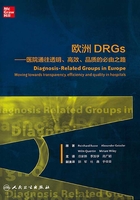
上QQ阅读APP看书,第一时间看更新
3.4 参考文献
Berki, S.E. (1985). DRGs, incentives, hospitals, and physicians. Health Affairs (Millwood),4(4):70-6.
Brügger, U. (2010). Impact of DRGs: Introducing a DRG Reimbursement System. A Literature Review. Zurich: SGGP (Schriftenreihe der SGGP, Vol. 98).
Busse, R., Schreyögg, J. ,Smith, P.C. (2008). Variability in healthcare treatment costs amongst nine EU countries - results from the HealthBASKET project. Health Economics,17(Suppl. 1):1-8.
Chalkley, M., Malcomson, J.M. (1998). Contracting for health services when patient demand does not reflect quality. Journal of Health Economics, 17(1):1-19.
Chapko, M.K., Liu, C., Perkins, M. et al. (2009). Equivalence of two healthcare costing methods: bottom-up and top-down. Health Economics, 18(10):1188-201.
Davis, C., Rhodes, D.J. (1988). The impact of DRGs on the cost and quality of health care in the United States. Health Policy, 9(2):117-31.
Donabedian, A. (1966). Evaluating the quality of medical care. The Milbank Memorial Fund Quarterly, 44(3)2:166-203.
European Parliament and Council (2011). Directive 2011/24/EU on the Application of Patients' Rights in Cross-Border Healthcare. Brussels: Official Journal of the European Union (L88/45-L88/65).
Farrar, S., Yi, D., Sutton, M. et al. (2009). Has payment by results affected the way that English hospitals provide care? Difference-in-differences analysis. British Medical Journal, 339:b3047.
France, F.H.R. (2003). Casemix use in 25 countries: a migration success but international comparisons failure. International Journal of Medical Informatics, 70(2-3):215-19.
Jacobs, R., Smith, P., Street, A. (2006). Measuring Efficiency in Health Care. Cambridge:Cambridge University Press.
Kimberly, J.R., de Pouvourville, G., D'Aunno, T., eds (2008). The Globalization ofManagerial Innovation in Health Care. Cambridge: Cambridge University Press.
Lave, J.R. (2003). Developing a Medicare prospective payment system for inpatient psychiatric care. Health Affairs (Millwood), 22(5):97-109.
Legido-Quigley, H., McKee, M., Nolte, E., Glinos, I.A. (2008). Assuring the Quality of Health Care in the European Union: A Case for Action. Copenhagen: WHO Regional Office for Europe on behalf of the European Observatory on Health Systems and Policies.
McCrone, P., Phelan, M. (1994). Diagnosis and length of psychiatric inpatient stay. Psychological Medicine, 24(4):1025-30.
MedPAC (2003). Payment for new technologies in Medicare's prospective payment system, in MedPAC. Report to the Congress: Medicare Payment Policy. Washington, DC:Medicare Payment Advisory Commission.
OTA (1983). Diagnosis-Related Groups (DRGs) and the Medicare Program: Implications for Medical Technology-A Technical Memorandum. Washington, DC: Office of Technology Assessment.
Quentin, W., Scheller-Kreinsen, D., Geissler, A., Busse, R. (in press). Appendectomy and diagnosis-related groups (DRGs): patient classification and hospital reimbursement in 11 European countries. Langenbeck's Archives of Surgery (in press).
Rogers, W.H., Draper, D., Kahn, K.L. et al. (1990). Quality of care before and after implementation of the DRG-based prospective payment system. A summary of effects. Journal of the American Medical Association, 264(15):1989-94.
Schreyögg, J. , Stargardt, T., Tiemann, O., Busse, R. (2006). Methods to determine reimbursement rates for diagnosis related groups (DRG): a comparison of nine European countries. Health Care Management Science, 9(3):215-23.
Shih, C., Berliner, E. (2008). Diffusion of new technology and payment policies: coronary stents. Health Affairs (Millwood), 27(6):1566-76.
Shleifer, A (1985). A theory of yard stick competition. The RAND Journal of Economics,16(3):319-27.
Smith, P.C., Mossialos, E., Papanicolas, I., Leatherman, S. (2010). Conclusions, in P.C.Smith, ed. Performance Measurement for Health System Improvement. Cambridge:Cambridge University Press.
(马骋宇 译)